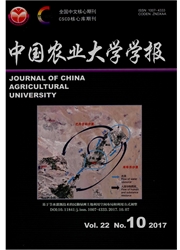

 中文摘要:
中文摘要:
为准确估算东北地区春玉米不同生育阶段内的蒸散发量,本研究基于锦州农田生态系统野外观测站2007—2008年涡度相关系统的春玉米蒸散发数据,利用相关系数、平均偏差和均方根误差等量化指标,结合线性加权和法,综合评价了6种日尺度蒸散发模型(组合法:FAO 56-Penman-Monteith;温度法:Hargreaves-Samani、Blaney-Criddle;辐射法:Makkink、Jensen-Haise、Priestley-Taylor)在春玉米不同生育阶段的适用性。结果表明:1)春玉米不同生育阶段内蒸散发平均日动态均呈单峰型曲线变化,生长季内日蒸散发量峰值出现在花粒期初;2)春玉米不同生育阶段反映了其稀疏程度导致的覆盖度差异对蒸散发的影响。综合评价结果表明,除PriestleyTaylor模型外,基于辐射法模型的模拟效果整体优于组合法和温度法模型;3)苗期的修正Blaney-Cridele模型、花粒期的修正Makkink模型以及穗期的原始Jensen-Haise模型具有较高的模拟精度,为东北春玉米不同生育阶段日蒸散发量的准确估算提供参考。
 英文摘要:
英文摘要:
In order to accurately estimate the evapotranspiration of spring maize at different growth stages,the applicability of six daily evapotranspiration models(Combined method,FAO 56-Penman-Monteith;Temperature-based methods,Hargreaves-Samani and Blaney-Criddle;Radiation-based methods,Makkink,Jensen-Haise and PriestleyTaylor)were evaluated in spring maize farmland ecosystem.This study was conducted based on latent flux data from eddy covariance during 2007—2008 at Jinzhou Agricultural Ecosystem Research Station and by using the linear weighted sum method and three statistical indicators:correlation coefficient,mean bias error and root mean square error.The results showed that:1)The average daily variation of evapotranspiration at different growth stages was expressed as a single peak curve and the maximum of daily evapotranspiration appeared at initial stage of flowering;2)Different canopy density differences of spring maize at different growth stages displayed effect on evapotranspiration.The general evaluation results indicated that the radiation-based models performed better than combined and temperature-based methods excluding Priestley-Taylor model;3)The calibrated Blaney-Criddle model in seedling stage,the original Jensen-Haise model in heading stage and the calibrated Makkink model in flowering stage accurately evaluated the evapotranspiration of spring maize.In conclusion,the results provide references for estimating daily spring maize evapotranspiration at different growth stages in Northeast,China.
 同期刊论文项目
同期刊论文项目
 同项目期刊论文
同项目期刊论文
 期刊信息
期刊信息
